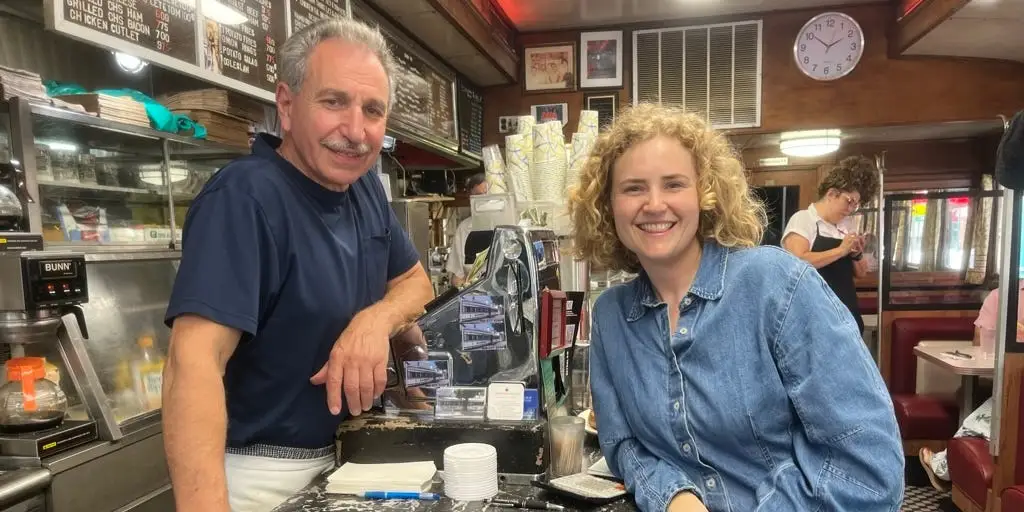
For the middle of the week, I thought it’d be quieter. Boy, was I wrong. Behind the scenes, the kitchen was firing food nonstop. Cooks go through 21,600 eggs a week. Stephen McCormick, the Executive Chef of Tops, told me people order pasta with Alfredo sauce at 8 in the morning, and stacks of pancakes late at night.
The egg rolls ($15) came with a sweet and spicy Thai chili and honey mustard sauce. I was impressed with how much Philly cheesesteak flavor they packed into a tiny bite. But these were so rich that I probably wouldn’t be able to eat a full order alone.
This is a New Jersey classic: a pile of fries smothered in gravy and topped with melty mozzarella. The gravy was rich, the cheese deliciously springy, and the fries somehow held their crunch. This is such an indulgent dish. I can see why Disco Fries are a favorite late-night eat in the state.
After my meal at Tops, I left wondering if this place can still be considered a diner. It’s more expensive and expansive than any I’d ever seen. But that scale has allowed Golemis to experiment with new flavors and bring in a lot of hungry eaters. Is this the diner of the future?
I went on another Wednesday morning, and just like Tops, Summit Diner was buzzing. Located in Summit, New Jersey, the diner opened in 1928. It’s one of the oldest left in the state and one of the last remaining examples of a pre-fabricated diner manufactured by the Jerry O’Mahony Diner Company.
Diners can trace their roots back to Rhode Island in the 1870s. First, they were horse-drawn lunch wagons serving sandwiches to newspaper workers on the night shift.
But it was New Jersey’s factories that built most of the pre-fabricated diners shipped across the US in the 20th century.
It’s estimated that the Jerry O’Mahony Company built 2,000 diners by the time it shuttered in the 1950s.
I spoke with Summit employee Maelin Mejis, who said that when she was first hired, the waitresses were practically singing. She’d memorize the orders and holler to the cooks: “Two eggs over easy. One corned beef hash!” Now, she dances around the restaurant, writing down orders with a pen and paper and figuring out tabs with a calculator. No credit cards are in sight.
There was no paper menu. You just look up and scan. I found that it allowed for a lot more conversation with the staff when I was looking up at a menu instead of looking down. And unlike Tops, Summit only had a few dozen options to choose from, so I didn’t find it overwhelming.
He’s tried experimenting with fruit, but people don’t order it. And avocado? He said he won’t serve it because it goes bad quickly, and his team doesn’t know how to work with it. After 40 years in the business, Greberis says he knows what works best, and he sticks to the classics.
Labor’s gotten more expensive, and food costs have soared. Eggs surged from $1.20 a dozen before COVID to $8.60. They’ve since leveled out to $3.75. Small diners like this just don’t have the volume to be able to absorb those costs. Greberis had to raise his prices, but at $9.25 an omelet, nearly half the price of Tops’, his prices still seem more than fair.
Despite surviving all these challenges, a more humble threat might spell the end of Summit. Greberis’ kids don’t want to take over the family restaurant. He worries about selling the business to another family because he said the land is worth more than the business, and they might tear it down. I wondered, could it even be Summit Diner without Jimmy?
The pancakes and Taylor Ham were amazing. But more than the food, this place is a vibe. It’s comforting. You feel like you’ve known the staff for years, even if you just walked through the doors. It’s as if the whole town squeezes into just a few booths. The mayor just happened to be eating lunch the day we visited!
While Summit and Tops have taken two very different approaches to an American diner, I think they represent a path forward for the waning category.
Tops has innovated, firing up bold flavors and slinging out liquor, much to its customers’ delight. Whereas Summit stuck with tradition, and that’s worked because the town revels in its history.
If there’s going to be a future for diners, there has to be room for both kinds. But the real reason I think diners are forever isn’t the food; it’s the people—the owners, cooks, and waitresses who keep the energy humming and the hungry diners who keep coming back for more.



